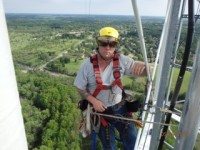By Benjamin Horvath – Inside Towers Special Correspondent

Decades ago, the tower climber occupation was known for its dangerous working conditions, as safety regulations and practices had not yet been developed for the burgeoning industry.
Many veteran climbers share stories of job sites in the old days, and they will tell you just how far the industry has evolved in climber safety.
James Allen, a near two-decade climbing veteran, is one such climber. And if there were ever an individual who could speak competently on safety in the industry, Allen’s it.
In 1997, Allen entered the industry after working as a high-risk painter on silos located in underground salt mines, something, he said, which prepared him well for the tower industry.
“I was walking steel beams that were up in the air, and then somebody told me about (tower climbing), and I said ‘I’ll give it a try,” Allen said.
During those early years as a climber, Allen said climber safety standards were “very, very poor,” and did not begin improving until roughly 15 years ago.
“You didn’t even need to wear a full-body harness,” Allen said. “You could climb a tower from the waist up in shorts and a pair of boots.”
Over his 20 years in the industry, Allen has worked for several different tower companies, including Magnum Towers, Capital Towers, Black & Veatch, Fortune Wireless and others.
The industry’s improved safety standards are something the 47-year-old Allen pays extremely close attention to nowadays — he had a near-fatal climbing accident over a decade ago.
“I fell off a water tank because I was not using proper safety gear and I was trying to cross from an angle onto a ladder and I slipped,” he said.
Allen rattled off the litany of injuries he sustained, which included two shattered hips, a collapsed lung and multiple breaks in his neck and back. When described, it’s an injury that would compel most to search for a new job, but after a three-month coma and 18 surgeries, Allen said he wanted to climb again.
“As soon as I could walk I was back on a tower site three months later,” he said. “I was not hesitant to get back out there, because I wanted to show everybody that I could still do it.”
As one would expect, Allen places an extremely high premium on climber safety. In fact, this is the one piece of advice he said he gives each new climber.
“Use all safety 100% of the time and listen to everyone else because they all can help you stay alive as well as them—just safety all the time,” Allen said.
Currently, Allen works as a tower crew foreman for Stout Tower Services, an Indiana-based wireless construction company with whom he has been employed since 2012. As a foreman, he emphasizes safety to his crews daily.
“We have JSA (job safety analysis) meetings every day and review all safety procedures, which I enforce at all times,” Allen said.
After two decades in the industry, Allen said he has no plans to stop climbing anytime soon.
“I want to do it as long as I can, as long as my body will let me.”




Reader Interactions